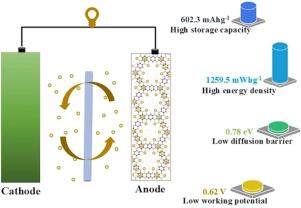氮杂-三苯基共价有机骨架:高效钠离子电池阳极
IF 8.9
2区 工程技术
Q1 ENERGY & FUELS
引用次数: 0
摘要
本研究通过第一性原理密度泛函理论考察了新合成的氮杂-三苯基共价有机骨架(aza-COF)作为钠离子电池(SIBs)负极材料的适用性。本工作确定了二维aza-COF为直接带隙半导体,能隙为1.02 eV。当钠在最可靠的位置加载时,aza-COF系统从半导体状态变为金属状态,从而提高了导电性。Aza-COF的扩散势垒为0.78 eV,理论比容量为602.3 mAhg−1,能量密度为1259.5 mWhg−1,平均电压为0.62 V,在0.1-1.0 V的理想范围内。此外,其结构适应性进一步支持其适合此类应用。此外,aza-COF对电解质具有很强的亲和力,突出了其对电极应用的特殊适用性。这些令人信服的理论结果表明,aza-COF可以作为sib的高效阳极材料本文章由计算机程序翻译,如有差异,请以英文原文为准。

Aza-triphenylene-based covalent organic framework: Anode for high-efficiency sodium-ion batteries
This research examines the suitability of newly synthesized aza-triphenylene based covalent organic framework (aza-COF) as a negative electrode material for sodium-ion batteries (SIBs) through first-principles density functional theory. This work identifies the two-dimensional aza-COF as a direct band gap semiconductor with an energy gap of 1.02 eV. When sodium is loaded at the most reliable location, the aza-COF system changes from a semiconductor to a metallic state, leading to improved electrical conductivity. Aza-COF shows a diffusion barrier of 0.78 eV, a high theoretical specific capacity of 602.3 mAhg−1, an energy density of 1259.5 mWhg−1, and mean voltage of 0.62 V falling within the ideal range of 0.1–1.0 V. Additionally, its structural adaptability further supports its suitability for such applications. Also, aza-COF demonstrates a strong affinity for electrolytes highlighting its exceptional suitability for electrode applications. These compelling theoretical results indicate that aza-COF could function as a highly efficient anode material for SIBs
求助全文
通过发布文献求助,成功后即可免费获取论文全文。
去求助
来源期刊

Journal of energy storage
Energy-Renewable Energy, Sustainability and the Environment
CiteScore
11.80
自引率
24.50%
发文量
2262
审稿时长
69 days
期刊介绍:
Journal of energy storage focusses on all aspects of energy storage, in particular systems integration, electric grid integration, modelling and analysis, novel energy storage technologies, sizing and management strategies, business models for operation of storage systems and energy storage developments worldwide.
 求助内容:
求助内容: 应助结果提醒方式:
应助结果提醒方式:


